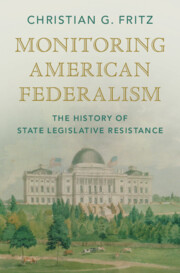Book contents
- Monitoring American Federalism
- Studies in Legal History
- Monitoring American Federalism
- Copyright page
- Dedication
- Contents
- Acknowledgments
- Introduction
- 1 The Riddle of Federalism and the Genesis of Interposition
- 2 Early State Use of Interposition: Testing the Powers of the New National Government
- 3 State Interposition and Debates over the Meaning of the Constitution
- 4 The Virginia and Kentucky Resolutions and Madison’s Report of 1800
- 5 State Interposition during the Jefferson and Madison Presidencies
- 6 State Challenges to the Supreme Court’s Control over Constitutional Interpretation
- 7 The Transformation of Interposition: The Theory of Nullification Emerges
- 8 State Interposition and Nullification on the Path to Secession
- 9 State Interposition during and after the Civil War
- 10 Modern Interposition by States and “Nullification”
- Abbreviations
- Notes
- Selected Short Titles
- Index
6 - State Challenges to the Supreme Court’s Control over Constitutional Interpretation
Published online by Cambridge University Press: 05 January 2023
- Monitoring American Federalism
- Studies in Legal History
- Monitoring American Federalism
- Copyright page
- Dedication
- Contents
- Acknowledgments
- Introduction
- 1 The Riddle of Federalism and the Genesis of Interposition
- 2 Early State Use of Interposition: Testing the Powers of the New National Government
- 3 State Interposition and Debates over the Meaning of the Constitution
- 4 The Virginia and Kentucky Resolutions and Madison’s Report of 1800
- 5 State Interposition during the Jefferson and Madison Presidencies
- 6 State Challenges to the Supreme Court’s Control over Constitutional Interpretation
- 7 The Transformation of Interposition: The Theory of Nullification Emerges
- 8 State Interposition and Nullification on the Path to Secession
- 9 State Interposition during and after the Civil War
- 10 Modern Interposition by States and “Nullification”
- Abbreviations
- Notes
- Selected Short Titles
- Index
Summary
A series of important lawsuits in the 1820s represented an increasingly stark division in American thinking about the role and authority of the Supreme Court in: Hunter v. Martin, Devise of Fairfax (1814), Martin v. Hunter’s Lessee (1816), McCulloch v. Maryland (1819), and Cohens v. Virginia (1821). That debate over federalism reflected fundamentally different views of the foundation and formation of the Constitution. For John Marshall and other nationally minded Americans, the Constitution had been established as the act of one national people, forming a national government with considerable powers. For states’ rights advocates, the Constitution was a compact of sovereign states, leaving state sovereignty largely intact except for limited and express grants of powers to the national government. Those competing views shaped how each side regarded the role and authority of the Supreme Court, and rhetoric became more extreme as nationalists feared disunion and states’ rights advocates feared the disintegration of state authority, including over slavery.
Keywords
- Type
- Chapter
- Information
- Monitoring American FederalismThe History of State Legislative Resistance, pp. 163 - 195Publisher: Cambridge University PressPrint publication year: 2023

